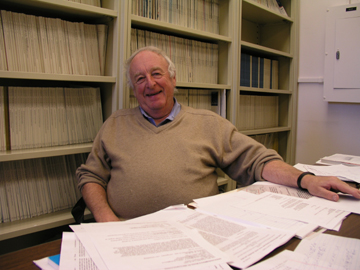
Geotimes Home | AGI Home | Information Services | Geoscience Education | Public Policy | Programs | Publications | Careers

 The first thing
noticeable on walking into Don Turcotte's office at the University of California,
Davis, is a long table strewn with papers and manuscripts in process, covered
with edits and pasted corrections, plus a few textbooks. Two textbooks are by
Turcotte: Geodynamics, with Gerald Schubert, and a volume Turcotte wrote
on fractals and geophysics, the first defining textbook in the field. Floor-to-ceiling
metal shelves hem in the work surface, filled with journals, some collected since
the beginning of his almost half-century career, and the window on the far wall
frames a winter view of a dry California valley, with a few pine trees stretching
toward blue sky.
The first thing
noticeable on walking into Don Turcotte's office at the University of California,
Davis, is a long table strewn with papers and manuscripts in process, covered
with edits and pasted corrections, plus a few textbooks. Two textbooks are by
Turcotte: Geodynamics, with Gerald Schubert, and a volume Turcotte wrote
on fractals and geophysics, the first defining textbook in the field. Floor-to-ceiling
metal shelves hem in the work surface, filled with journals, some collected since
the beginning of his almost half-century career, and the window on the far wall
frames a winter view of a dry California valley, with a few pine trees stretching
toward blue sky.  |
Geotimes Home | AGI Home | Information Services | Geoscience Education | Public Policy | Programs | Publications | Careers |